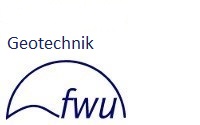Development of a macro-element model for coupled simulation of foundation - structure interaction of wind turbines
| Operational time: |
01.01.2023 - 31.12.2023 |
| Sponsor: |
Ministry of Economic Affairs, Innovation, Digitalization and Energy of the State of North Rhine-Westphalia, funding guideline "Program for rational energy use, regenerative energies and energy saving - progres.nrw - Research program area", funding code 005-2206-0039_0208 |
| Resonsible: |
Kachallah A. Kau, M.Sc. |
Brief Desription:
The consideration of the soil-structure interaction has a significant influence on the dynamic behavior of a wind turbine (WEA). For example, the natural frequency depends on the resulting system stiffness. So far, for onshore wind turbines (OnWEA), the interaction between structure and foundation is represented in the dynamic structural analysis by simplified spring models (e.g. dynamic equivalent torsion spring). The parameters of these spring models are calibrated in a geotechnical calculation without direct coupling with the structural dynamics, which is why the load determination must be iterative. The resulting uncertainty in the determination of the dynamic parameters can lead to a system design on the unsafe or the safe side. In the future, with larger rated power and thus higher dynamic loads of OnWEA, such a strong simplification is no longer acceptable. At the Chair of Geotechnical Engineering of the University of Siegen, an interface in the open source code OpenFAST for the explicit coupling of the dynamic structural analysis with the analysis of the foundation support behavior for a floating WEA was developed within the scope of research work on offshore WEA. The present project will now explore how this interface can be applied to the design of OnWEA. So far, the interface couples 3D finite element (FE) modeling of the substructure with dynamics analysis of the WEA. However, FE modeling is too costly for OnWEA. Therefore, it will be investigated whether a macro element of the entire foundation can be implemented instead. A macro element is used to formulate a relationship between all load components and associated displacement/rotation components of the foundation body, which allows the soil-structure interaction to be captured in the dynamic structural analysis realistically but with reasonable effort. This enables an efficient and reliable design of future high performance OnWEA.
